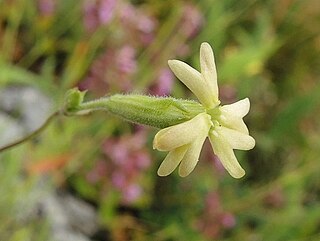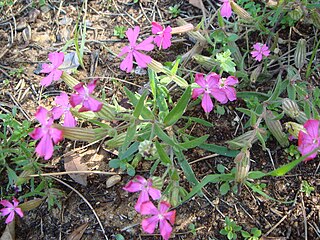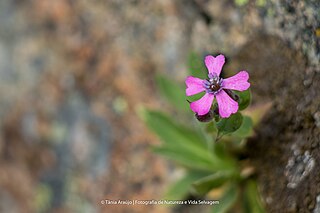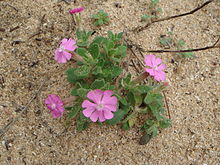
Sex is the trait that determines whether a sexually reproducing organism produces male or female gametes. During sexual reproduction, a male and a female gamete fuse to form a zygote, which develops into an offspring that inherits traits from each parent. By convention, organisms that produce smaller, more mobile gametes are called male, while organisms that produce larger, non-mobile gametes are called female. An organism that produces both types of gamete is hermaphrodite.

Silene is a genus of flowering plants in the family Caryophyllaceae. Containing nearly 900 species, it is the largest genus in the family. Common names include campion and catchfly. Many Silene species are widely distributed, particularly in the northern hemisphere.

Charophyta is a group of freshwater green algae, called charophytes, sometimes treated as a division, yet also as a superdivision or an unranked clade. The terrestrial plants, the Embryophyta emerged deep within Charophyta, possibly from terrestrial unicellular charophytes, with the class Zygnematophyceae as a sister group.
Dioecy is a characteristic of certain species that have distinct unisexual individuals, each producing either male or female gametes, either directly or indirectly. Dioecious reproduction is biparental reproduction. Dioecy has costs, since only the female part of the population directly produces offspring. It is one method for excluding self-fertilization and promoting allogamy (outcrossing), and thus tends to reduce the expression of recessive deleterious mutations present in a population. Plants have several other methods of preventing self-fertilization including, for example, dichogamy, herkogamy, and self-incompatibility.

The lychnis is a moth of the family Noctuidae. It is found in northern and western Europe and Turkey. It has an Atlantic-Mediterranean distribution. In the East Palearctic it is replaced by Hadena capsincola.

Silene latifolia, commonly known as white campion, is a dioecious flowering plant in the family Caryophyllaceae, native to most of Europe, Western Asia and northern Africa. It is a herbaceous annual, occasionally biennial or a short-lived perennial plant, growing to between 40–80 centimetres tall. It is also known in the US as bladder campion but should not be confused with Silene vulgaris, which is more generally called bladder campion.

Silene dioica, known as red campion and red catchfly, is a herbaceous flowering plant in the family Caryophyllaceae, native to Europe and introduced to the Americas.

Gynodioecy is a rare breeding system that is found in certain flowering plant species in which female and hermaphroditic plants coexist within a population. Gynodioecy is the evolutionary intermediate between hermaphroditism and dioecy.
In biology, a pathogen, in the oldest and broadest sense, is any organism or agent that can produce disease. A pathogen may also be referred to as an infectious agent, or simply a germ.

Silene is a flowering plant genus that has evolved a dioecious reproductive system. This is made possible through heteromorphic sex chromosomes expressed as XY. Silene recently evolved sex chromosomes 5-10 million years ago and are widely used by geneticists and biologists to study the mechanisms of sex determination since they are one of only 39 species across 14 families of angiosperm that possess sex-determining genes. Silene are studied because of their ability to produce offspring with a plethora of reproductive systems. The common inference drawn from such studies is that the sex of the offspring is determined by the Y chromosome.

Diphasic sex expression, is defined as the alteration of the primary sex during the lifetime of an individual found within dioecious and subdioecious species. This change in sex expression is a response to environmental cues such as sun exposure and rainfall or drought levels. Labile sex expression is a type of diphasic sex expression that is found among many perennial plant species, and is defined as the switch from male to female once the plant has reached a certain size. In species with labile sex expression this change occurs only once, where as a plant expressing diphasic sex tendencies can switch from season to season.

Silene flavescens are flowering plants part of the genus Silene, family Caryophyllaceae. They are widely distributed and are found in the northern hemisphere. They are native to Hungary and the Balkan Peninsula. It is an herbaceous species belonging to the tribe Sileneae
Andromonoecy is a breeding system of plant species in which male and hermaphrodite flowers are on the same plant. It is a monomorphic sexual system comparable with monoecy, gynomonoecy and trimonoecy. Andromonoecy is frequent among genera with zygomorphic flowers, however it is overall rare and occurs in less than 2% of plant species. Nonetheless the breeding system has gained interest among biologists in the study of sex expression.
Gynomonoecy is defined as the presence of both female and hermaphrodite flowers on the same individual of a plant species. It is prevalent in Asteraceae but is poorly understood.

A sexual system is a distribution of male and female function across organisms in a species. The terms reproductive system and mating system have also been used as synonyms.
Dioicy is a sexual system where archegonia and antheridia are produced on separate gametophytes. It is one of the two main sexual systems in bryophytes, the other being monoicy. Both dioicous and monoicous gametophytes produce gametes in gametangia by mitosis rather than meiosis, so that sperm and eggs are genetically identical with their parent gametophyte.

Silene disticha is a species of flowering plant. The species is hermaphroditic and mainly grows in the subtropics.

Silene stockenii is a species of flowering plant in the Caryophyllaceae first described in 1973. The specific epithet is named after Christopher Maitland Stocken, who discovered it in 1962 in Bornos. It is native to Spain, where it is endemic to grasslands growing in calcareous soil on formations made from calcarenite west of Cádiz in Andalusia. It is currently listed as critically endangered. In 1993, the number of individuals belonging to this species was estimated to be below 2000.

Silene acutifolia is a species of herb native to northwest Spain as well as central and northern Portugal. The species is polycarpic and usually grows in rocky environments.

Silene italica is a species of plant native to Southern Europe and parts of Asia. It is also introduced to parts of the United States and Northern Europe.















